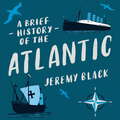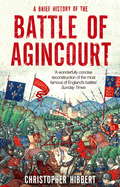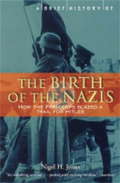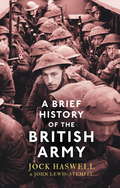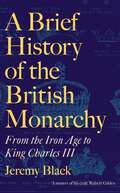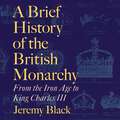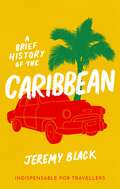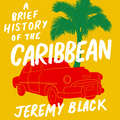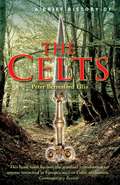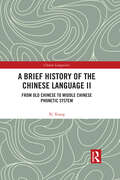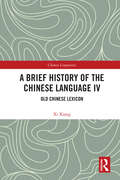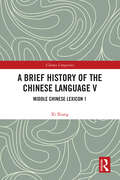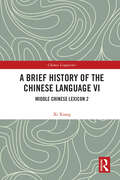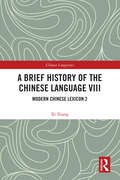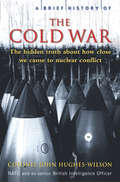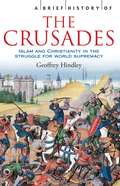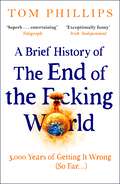- Table View
- List View
A Brief History of the Atlantic (Brief Histories)
by Jeremy BlackThe Atlantic has borne witness to major historic events that have drastically shaped humanity with each crossing of its path. In this broad and readable book, Jeremy Black takes the reader through its evolution to becoming one of the most important oceans in the world.Black discusses the importance of the Atlantic in relation to world history as well as addressing topics such as those bravest to attempt to cross the ocean before Columbus, the beginnings of slavery from 1400-1600, the struggle for control between empires in the 1600s, the way technology adapted with steamships to telegraph cables, the battle of the Falkland, and the Cold War.Black also touches on the Atlantic we know today, and the struggles it faces due to urgent global issues including climate change, pollution, and the trials of the economic rise in the Indo-Pacific world. If you have ever yearned to know more about this famed and vital ocean, this clear and concise history will be a key read as one of the first of its kind on its evolution to becoming an established world ocean.
A Brief History of the Battle of Agincourt
by Christopher HibbertThere can be few military victories so complete, or achieved against such heavy odds, as that won by Henry V on 25 October 1415 against Charles VI's army at Agincourt. In the words of one contemporary French chronicler, it was the 'most disgraceful event that had ever happened to the Kingdom of France'.Christopher Hibbert's wonderfully concise account draws on the unusual number of contemporary sources available to historians to describe in lucid detail not only what happened, but how it happened. His classic account of the crushing defeat of the French at Agincourt combines historical rigour with a vigorous and very readable narrative style.
A Brief History of the Battle of Agincourt (Brief Histories)
by Christopher HibbertThere can be few military victories so complete, or achieved against such heavy odds, as that won by Henry V on 25 October 1415 against Charles VI's army at Agincourt. In the words of one contemporary French chronicler, it was the 'most disgraceful event that had ever happened to the Kingdom of France'.Christopher Hibbert's wonderfully concise account draws on the unusual number of contemporary sources available to historians to describe in lucid detail not only what happened, but how it happened. His classic account of the crushing defeat of the French at Agincourt combines historical rigour with a vigorous and very readable narrative style.
A Brief History of the Birth of the Nazis
by Nigel JonesThe birth pangs of Nazism grew out of the death agony of the Kaiser's Germany. Defeat in World War I and a narrow escape from Communist revolution brought not peace but five chaotic years (1918-1923) of civil war, assassination, plots, putsches and murderous mayhem to Germany. The savage world of the trenches came home with the men who refused to admit defeat and 'who could not get the war out of their system'. It was an atmosphere in which civilised values withered, and violent extremism flourished. In this chronicle of the paramilitary Freikorps - the freebooting armies that crushed the Red revolution, then themselves attempted to take over by armed force - historian and biographer Nigel Jones draws on little-known archives in Germany and Britain to paint a portrait of a state torn between revolution and counter revolution. Astonishingly, this is the first in-depth study of the Freikorps to appear in English for 50 years. Yet the figures who flit through its shadowy world - men like Röhm, Goering and Hitler himself - were to become frighteningly familiar just ten years after the turmoil that gave Nazism its fatal chance.
A Brief History of the British Army
by John Lewis-Stempel Jock HaswellThe story of the British Army has many sides to it, being a tale of heroic successes and tragic failures, of dogged determination and drunken disorder. It involves many of the most vital preoccupations in the history of the island - the struggle against Continental domination by a single power, the battle for Empire - and a cast pf remarkable characters - Marlborough, Wellington and Montgomery among them. Yet the British, relying on their navy, have always neglected their army; from the time of Alfred the Great to the reign of Charles II wars were fought with hired forces disbanded as soon as conflict ended. Even after the stuggles with Louis XIV impelled the formation of a reulgar army, impecunious governments neglected the armed forces except in times of national emergency. In this wide-ranging account, Major Haswell sketches the medieval background before concentrating on the three hundred years of the regular army, leading up to its role in our own time. He presents an informed and probing picture of the organization of the army, the development of weaponry and strategy - and the everyday life of the British soldier through the centuries.John Lewis-Stempel has brought Major Haswell's classic work right up to date by expanding the section on the dissolution of empire to include a full account of Northern Ireland and the Falklands War. He has added a new chapter to cover the Gulf War, Bosnia, Afghanistan and Iraq; also the increasing role of special forces and the amalgamation of regiments.
A Brief History of the British Army (Brief Histories)
by John Lewis-Stempel Major Jock HaswellThe story of the British Army has many sides to it, being a tale of heroic successes and tragic failures, of dogged determination and drunken disorder. It involves many of the most vital preoccupations in the history of the island - the struggle against Continental domination by a single power, the battle for Empire - and a cast pf remarkable characters - Marlborough, Wellington and Montgomery among them. Yet the British, relying on their navy, have always neglected their army; from the time of Alfred the Great to the reign of Charles II wars were fought with hired forces disbanded as soon as conflict ended. Even after the stuggles with Louis XIV impelled the formation of a reulgar army, impecunious governments neglected the armed forces except in times of national emergency. In this wide-ranging account, Major Haswell sketches the medieval background before concentrating on the three hundred years of the regular army, leading up to its role in our own time. He presents an informed and probing picture of the organization of the army, the development of weaponry and strategy - and the everyday life of the British soldier through the centuries.John Lewis-Stempel has brought Major Haswell's classic work right up to date by expanding the section on the dissolution of empire to include a full account of Northern Ireland and the Falklands War. He has added a new chapter to cover the Gulf War, Bosnia, Afghanistan and Iraq; also the increasing role of special forces and the amalgamation of regiments.
A Brief History of the British Monarchy: From the Iron Age to King Charles III
by Jeremy BlackThe British monarchy is at a turning point. Concise and engaging, this book charts the very beginnings of British reign through to the longest serving monarch, Queen Elizabeth II - and looks forward to the reign of King Charles III.Much more than a linear history, this is the intertwined story of royalty and state, of divisions, invasions, rivalries, death and glory; the story of nation fates deeply tied with the personal endeavours of monarchs through the ages. Black expertly weaves together thematic chapters from the origins of monarchy, medieval times and sixteenth-century developments, to the crises of the seventeenth-century, settlement and imperialism, and the challenges of the modern age. Exploring the House of Wessex, the Norman Conquest, Henry VIII and the Tudors, Victorianism and key events such as abdication of Edward VIII, this book is a necessary and comprehensive guide to the British Monarchy and how it has shaped history - and our lives today.
A Brief History of the British Monarchy: From the Iron Age to King Charles III
by Jeremy BlackThe British monarchy is at a turning point. Concise and engaging, this book charts the very beginnings of British reign through to the longest serving monarch, Queen Elizabeth II - and looks forward to the reign of King Charles III.Much more than a linear history, this is the intertwined story of royalty and state, of divisions, invasions, rivalries, death and glory; the story of nation fates deeply tied with the personal endeavours of monarchs through the ages. Black expertly weaves together thematic chapters from the origins of monarchy, medieval times and sixteenth-century developments, to the crises of the seventeenth-century, settlement and imperialism, and the challenges of the modern age. Exploring the House of Wessex, the Norman Conquest, Henry VIII and the Tudors, Victorianism and key events such as abdication of Edward VIII, this book is a necessary and comprehensive guide to the British Monarchy and how it has shaped history - and our lives today.
A Brief History of the British Monarchy: From the Iron Age to King Charles III
by Jeremy BlackThe British monarchy is at a turning point. Concise and engaging, this book charts the very beginnings of British reign through to the longest serving monarch, Queen Elizabeth II - and looks forward to the reign of King Charles III.Much more than a linear history, this is the intertwined story of royalty and state, of divisions, invasions, rivalries, death and glory; the story of nation fates deeply tied with the personal endeavours of monarchs through the ages. Black expertly weaves together thematic chapters from the origins of monarchy, medieval times and sixteenth-century developments, to the crises of the seventeenth-century, settlement and imperialism, and the challenges of the modern age. Exploring the House of Wessex, the Norman Conquest, Henry VIII and the Tudors, Victorianism and key events such as abdication of Edward VIII, this book is a necessary and comprehensive guide to the British Monarchy and how it has shaped history - and our lives today.
A Brief History of the Caribbean: Indispensable for Travellers (Brief Histories)
by Jeremy BlackA concise history of the Caribbean's long and fascinating history, from pre-contact civilisations to the present day This is a concise history, intended for travellers, but of inestimable value to anyone looking for an overview of the Caribbean and its mainland coastal states, with a focus on the past few centuries. The history of the Caribbean does not make much sense without factoring in the cities - Pensacola, New Orleans, Galveston - and the ambitions of the states on its continental shores, notably the United States. This account is grounded in a look at the currents and channels of the sea, and its constraints, such as the Mosquito Coast, followed by the history of 'pre-contact' civilisations, focusing on the Maya and the Toltec Empire.With the arrival of the Europeans, from the late fifteenth century to the early years of the seventeenth century, the story becomes one of exploration, conquest and settlement. Black charts the rise of slave economies and the Caribbean's place in the Atlantic world, also the arrival of the English - Hawkins and Drake - to challenge the Spanish. He examines the sugar and coffee slave economies of the English, French, Spanish and Dutch, also the successful rebellion in Haiti in the eighteenth century, and how the West Indies were further transformed by the Louisiana Purchase, the American conquest of Florida and the incorporation of Texas.He discusses the impact of Bolivar's rebellion in Spanish America, the end of slavery in the British Caribbean, and war between Mexico and America; also the defeat of the South by the Union, the American takeover of the Panama Canal project from France, and the Spanish-American War.The first half of the twentieth century focuses on growing US power: intervention in Mexico, Honduras, Nicaragua, Panama, Haiti and the Dominican Republic; Cuba as an American protectorate, and civil wars in Mexico.The Cold War brought new tensions and conflict to the region, but the same period also saw the rise of the leisure industry. The last part of the book looks at the Caribbean today - political instability in Venezuela and Colombia, crime in Mexico, post-Castro Cuba - and the region's future prospects.
A Brief History of the Caribbean: Indispensable for Travellers (Brief Histories)
by Jeremy BlackA concise history of the Caribbean's long and fascinating history, from pre-contact civilisations to the present day This is a concise history, intended for travellers, but of inestimable value to anyone looking for an overview of the Caribbean and its mainland coastal states, with a focus on the past few centuries. The history of the Caribbean does not make much sense without factoring in the cities - Pensacola, New Orleans, Galveston - and the ambitions of the states on its continental shores, notably the United States. This account is grounded in a look at the currents and channels of the sea, and its constraints, such as the Mosquito Coast, followed by the history of 'pre-contact' civilisations, focusing on the Maya and the Toltec Empire.With the arrival of the Europeans, from the late fifteenth century to the early years of the seventeenth century, the story becomes one of exploration, conquest and settlement. Black charts the rise of slave economies and the Caribbean's place in the Atlantic world, also the arrival of the English - Hawkins and Drake - to challenge the Spanish. He examines the sugar and coffee slave economies of the English, French, Spanish and Dutch, also the successful rebellion in Haiti in the eighteenth century, and how the West Indies were further transformed by the Louisiana Purchase, the American conquest of Florida and the incorporation of Texas.He discusses the impact of Bolivar's rebellion in Spanish America, the end of slavery in the British Caribbean, and war between Mexico and America; also the defeat of the South by the Union, the American takeover of the Panama Canal project from France, and the Spanish-American War.The first half of the twentieth century focuses on growing US power: intervention in Mexico, Honduras, Nicaragua, Panama, Haiti and the Dominican Republic; Cuba as an American protectorate, and civil wars in Mexico.The Cold War brought new tensions and conflict to the region, but the same period also saw the rise of the leisure industry. The last part of the book looks at the Caribbean today - political instability in Venezuela and Colombia, crime in Mexico, post-Castro Cuba - and the region's future prospects.
A Brief History of the Caribbean: Indispensable for Travellers (Brief Histories)
by Jeremy BlackA concise history of the Caribbean's long and fascinating history, from pre-contact civilisations to the present day This is a concise history, intended for travellers, but of inestimable value to anyone looking for an overview of the Caribbean and its mainland coastal states, with a focus on the past few centuries. The history of the Caribbean does not make much sense without factoring in the cities - Pensacola, New Orleans, Galveston - and the ambitions of the states on its continental shores, notably the United States. This account is grounded in a look at the currents and channels of the sea, and its constraints, such as the Mosquito Coast, followed by the history of 'pre-contact' civilisations, focusing on the Maya and the Toltec Empire.With the arrival of the Europeans, from the late fifteenth century to the early years of the seventeenth century, the story becomes one of exploration, conquest and settlement. Black charts the rise of slave economies and the Caribbean's place in the Atlantic world, also the arrival of the English - Hawkins and Drake - to challenge the Spanish. He examines the sugar and coffee slave economies of the English, French, Spanish and Dutch, also the successful rebellion in Haiti in the eighteenth century, and how the West Indies were further transformed by the Louisiana Purchase, the American conquest of Florida and the incorporation of Texas.He discusses the impact of Bolivar's rebellion in Spanish America, the end of slavery in the British Caribbean, and war between Mexico and America; also the defeat of the South by the Union, the American takeover of the Panama Canal project from France, and the Spanish-American War.The first half of the twentieth century focuses on growing US power: intervention in Mexico, Honduras, Nicaragua, Panama, Haiti and the Dominican Republic; Cuba as an American protectorate, and civil wars in Mexico.The Cold War brought new tensions and conflict to the region, but the same period also saw the rise of the leisure industry. The last part of the book looks at the Caribbean today - political instability in Venezuela and Colombia, crime in Mexico, post-Castro Cuba - and the region's future prospects.
A Brief History of the Celts
by Peter EllisFor centuries the Celts held sway in Europe. Even after their conquest by the Romans, their culture remained vigorous, ensuring that much of it endured to feed an endless fascination with Celtic history and myths, artwork and treasures. A foremost authority on the Celtic peoples and their culture, Peter Berresford Ellis presents an invigoration overview of their world. With his gift for making the scholarly accessible, he discusses the Celts' mysterious origins and early history and investigates their rich and complex society. His use of recently uncovered firnds brings fascinating insights into Celtic kings and chieftains, architecture and arts, medicine and religions, myths and legends, making this esesntial reading for any search for Europe's ancient past.
A Brief History of the Celts (Brief Histories)
by Peter EllisFor centuries the Celts held sway in Europe. Even after their conquest by the Romans, their culture remained vigorous, ensuring that much of it endured to feed an endless fascination with Celtic history and myths, artwork and treasures. A foremost authority on the Celtic peoples and their culture, Peter Berresford Ellis presents an invigoration overview of their world. With his gift for making the scholarly accessible, he discusses the Celts' mysterious origins and early history and investigates their rich and complex society. His use of recently uncovered firnds brings fascinating insights into Celtic kings and chieftains, architecture and arts, medicine and religions, myths and legends, making this esesntial reading for any search for Europe's ancient past.
A Brief History of the Chinese Language II: From Old Chinese to Middle Chinese Phonetic System (Chinese Linguistics)
by Xi XiangAs the second volume of a multi-volume set on Chinese phonetics, this book examines the phonetical systems of Middle Chinese and phonetical changes from Old Chinese to Middle Chinese.Chinese language history is generally split into three phases: 1) Old Chinese, the form of the Chinese language spoken between the 18th century BC and the 3rd century AD, 2) Middle Chinese, between the 4th century AD to around the 12th century AD, and 3) Modern Chinese, since the 13th century. This volume studies the phonological system of Middle Chinese, including the initials system, finals system, and tonal system, examining the evolution of these systems from the period of Old Chinese to that of Middle Chinese.This comprehensive groundwork on Chinese phonetical history will be a must read for scholars and student studying Chinese language, linguistics and especially for beginning learners of Middle Chinese phonetics.
A Brief History of the Chinese Language IV: Old Chinese Lexicon (Chinese Linguistics)
by Xi XiangAs the fourth volume of a multi-volume set on the Chinese language, this book studies the lexical system of Old Chinese and the development of different types of lexicons during the period. Focusing on lexicons in Old Chinese, the early form of the Chinese language used between the 18th century BCE and the 3rd century CE, this volume first introduces the methods of word formation in Old Chinese by analyzing words inscribed in oracle bones of the Shang Dynasty. Illustrated with examples, it then examines the lexical features of Old Chinese and explores the progress and evolutionary features of monosyllabic words, polysyllabic words, lexical meanings, synonyms, and idioms and proverbs over the course of the volume.This comprehensive groundwork on Chinese lexical history is a must-read for scholars and students studying ancient Chinese language, linguistics, and especially for beginning learners of the Old Chinese lexicon.
A Brief History of the Chinese Language V: Middle Chinese Lexicon 1 (Chinese Linguistics)
by Xi XiangAs the fifth volume of a multi-volume set on the Chinese language, this book studies the development of monosyllables and polysyllables in Middle Chinese and the overall evolution of lexical meanings during the period.Focusing on lexicons in Middle Chinese, the Chinese language used between the 4th century AD and the 12th century AD, the book first introduces the monosyllabic neologisms of Middle Chinese, including characters and words derived from Old Chinese lexicons and those newly created. It then examines the development of polysyllabic words in Middle Chinese, ranging from single morpheme words, tautologies and compound words. The final chapter discusses the changes and extension of word meanings in medieval Chinese.Illustrated with abundant examples, this comprehensive groundwork on Chinese lexical history will be a must read for scholars and students studying ancient Chinese language, linguistics and especially for beginning learners of the Middle Chinese lexicon.
A Brief History of the Chinese Language VI: Middle Chinese Lexicon 2 (Chinese Linguistics)
by Xi XiangAs the sixth volume of a multi-volume set on the Chinese language, this book studies the influence of foreign culture on Middle Chinese lexicon and the development of synonyms, idioms and proverbs during the period.Focusing on lexicons in Middle Chinese, the middle form of the Chinese language used between the 4th century AD and the 12th century AD, this book first analyzes loanwords in Middle Chinese, a product of cultural exchange with western regions on the silk road and the impact of Buddhism. It then discusses the differences in meaning between monosyllables and polysyllables. The final chapter describes enriching idioms and proverbs and the major sources of words, including classical works, Buddhist texts and the spoken language.Illustrated with abundant examples, this comprehensive groundwork on Chinese lexical history will be a must read for scholars and students studying ancient Chinese language, linguistics and especially for beginning learners of the Middle Chinese lexicon.
A Brief History of the Chinese Language VIII: Modern Chinese Lexicon 2 (Chinese Linguistics)
by Xi XiangAs the final volume of a multi-volume set on the Chinese language, this book studies the Western and Japanese influence on the lexicon of Modern Chinese, lexical developments in synonyms, idioms and proverbs in modern times, and lexical developments in contemporary times.This volume first introduces the influence of foreign cultures on the modern Chinese lexicon with an emphasis on loanwords from Japanese and Indo-European languages. It then discusses the synonyms, idioms and proverbs of Modern Chinese, elucidating their evolution, sources and composition. The final part centers on the development of the Chinese lexicon after the May 4 Movement in 1919, marking the beginning of the contemporary phase of the Chinese language. The author analyses trends and types of neologisms and loanwords and analyzes the blend of Mandarin and dialect words as well as the necessity of lexical standardization.Illustrated with abundant examples, this comprehensive groundwork on Chinese lexical history will be a must read for scholars and students studying modern Chinese language, linguistics and especially for beginning learners of modern and contemporary Chinese lexicon.
A Brief History of the Cold War
by John Hughes-WilsonThe Cold War was an undeclared war, fought silently and carefully between ideological opponents armed with the most fearsome weapons mankind has ever seen. Hughes-Wilson takes a cool look at this war, from the Bolshevik Revolution of 1917 to the collapse of the Berlin Wall in 1989 and the dissolution of the USSR thereafter. He examines the suspicion and paranoia -- on both sides -- of the greatest stand-off in history. Written by one of Britain's leading, popular, military historians, this book makes accessible for the first time one of the key periods to shape our world.
A Brief History of the Cold War (Brief Histories)
by Colonel John Hughes-WilsonThe Cold War was an undeclared war, fought silently and carefully between ideological opponents armed with the most fearsome weapons mankind has ever seen. Hughes-Wilson takes a cool look at this war, from the Bolshevik Revolution of 1917 to the collapse of the Berlin Wall in 1989 and the dissolution of the USSR thereafter. He examines the suspicion and paranoia -- on both sides -- of the greatest stand-off in history. Written by one of Britain's leading, popular, military historians, this book makes accessible for the first time one of the key periods to shape our world.
A Brief History of the Crusades
by Geoffrey HindleyWhy did the medieval Church bless William of Normandy's invasion of Christian England in 1066 and authorise cultural genocide in Provence? How could a Christian army sack Christian Constantinople in 1204? Why did thousands of ordinary men and women, led by knights and ladies, kings and queens, embark on campaigns of fanatical conquest in the world of Islam? The word 'Crusade' came later, but the concept of a 'war for the faith' is an ancient one. Geoffrey Hindley instructively unravels the story of the Christian military expeditions that have perturbed European history, troubled Christian consciences and embittered Muslim attitudes towards the West. He offers a lively record of the Crusades, from the Middle East to the pagan Baltic, and fascinating portraits of the major personalities, from Godfrey of Bouillon, the first Latin ruler of Jerusalem, to Etienne, the visionary French peasant boy who inspired the tragic Children's Crusade. Addressing questions rarely considered, Hindley sheds new light on pressing issues surrounding religious division and shows how the Crusades have helped to shape the modern world and relations between Christian and Muslim countries to this day.
A Brief History of the Crusades (Brief Histories)
by Geoffrey HindleyWhy did the medieval Church bless William of Normandy's invasion of Christian England in 1066 and authorise cultural genocide in Provence? How could a Christian army sack Christian Constantinople in 1204? Why did thousands of ordinary men and women, led by knights and ladies, kings and queens, embark on campaigns of fanatical conquest in the world of Islam? The word 'Crusade' came later, but the concept of a 'war for the faith' is an ancient one. Geoffrey Hindley instructively unravels the story of the Christian military expeditions that have perturbed European history, troubled Christian consciences and embittered Muslim attitudes towards the West. He offers a lively record of the Crusades, from the Middle East to the pagan Baltic, and fascinating portraits of the major personalities, from Godfrey of Bouillon, the first Latin ruler of Jerusalem, to Etienne, the visionary French peasant boy who inspired the tragic Children's Crusade. Addressing questions rarely considered, Hindley sheds new light on pressing issues surrounding religious division and shows how the Crusades have helped to shape the modern world and relations between Christian and Muslim countries to this day.
A Brief History of the End of the F*cking World: The hilarious and fascinating new book from the international bestselling author of HUMANS
by Tom PhillipsDo you feel like we're living in the end times? Does it seem like everything is on fire, and one disaster follows another? Here's a small comfort: you're not the first to feel that way. If there's one thing that people throughout history have agreed on, it's that history wasn't going to be around for much longer.This book is about the apocalypse, and how humans have always believed it to be very f*cking nigh. Across thousands of years, we'll meet weird cults, failed prophets and mass panics, holy warriors leading revolts in anticipation of the last days, and suburbanites waiting for aliens to rescue them from a doomed Earth. We'll journey back to the 'worst period to be alive', as the world reeled from a simultaneous pandemic and climate crisis. And we'll look to the future to ask the unnerving question: how might it all end?But it's also a book about how we live in a world where catastrophe is always looming - whether it's a madman with a nuclear button or the slow burn of environmental collapse. Because when we talk about the end of the world, what we really mean is the end of our world. Our obsession with doomsday is really about change: our fear of it, and our desire for it, and how - ultimately - we can find hope in it.Praise for the Brief History series:'Uproarious . . . Abundant good humour' The Times'Witty, entertaining and slightly distressing... You should probably read it' Sarah Knight, author of The Life-Changing Magic of Not Giving a F*ck'Brilliant. Utterly, utterly brilliant' Jeremy Clarkson'Very funny' Mark Watson'Both readable and entertaining' Telegraph
A Brief History of the End of the F*cking World: The hilarious and fascinating new book from the international bestselling author of HUMANS
by Tom PhillipsDo you feel like we're living in the end times? Does it seem like everything is on fire, and one disaster follows another? Here's a small comfort: you're not the first to feel that way. If there's one thing that people throughout history have agreed on, it's that history wasn't going to be around for much longer.This book is about the apocalypse, and how humans have always believed it to be very f*cking nigh. Across thousands of years, we'll meet weird cults, failed prophets and mass panics, holy warriors leading revolts in anticipation of the last days, and suburbanites waiting for aliens to rescue them from a doomed Earth. We'll journey back to the 'worst period to be alive', as the world reeled from a simultaneous pandemic and climate crisis. And we'll look to the future to ask the unnerving question: how might it all end?But it's also a book about how we live in a world where catastrophe is always looming - whether it's a madman with a nuclear button or the slow burn of environmental collapse. Because when we talk about the end of the world, what we really mean is the end of our world. Our obsession with doomsday is really about change: our fear of it, and our desire for it, and how - ultimately - we can find hope in it.Praise for the Brief History series:'Uproarious . . . Abundant good humour' The Times'Witty, entertaining and slightly distressing... You should probably read it' Sarah Knight, author of The Life-Changing Magic of Not Giving a F*ck'Brilliant. Utterly, utterly brilliant' Jeremy Clarkson'Very funny' Mark Watson'Both readable and entertaining' Telegraph
